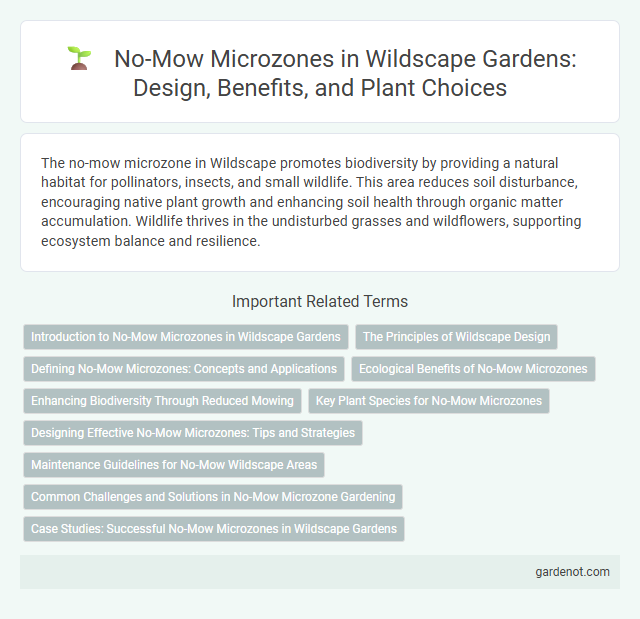The no-mow microzone in Wildscape promotes biodiversity by providing a natural habitat for pollinators, insects, and small wildlife. This area reduces soil disturbance, encouraging native plant growth and enhancing soil health through organic matter accumulation. Wildlife thrives in the undisturbed grasses and wildflowers, supporting ecosystem balance and resilience.
Introduction to No-Mow Microzones in Wildscape Gardens
No-mow microzones in Wildscape gardens create pockets of natural habitat by allowing native plants to grow undisturbed, supporting biodiversity and pollinators. These areas reduce maintenance while enhancing soil health and water retention through natural vegetation. Integrating no-mow microzones promotes ecological balance and encourages wildlife presence within designed landscapes.
The Principles of Wildscape Design
The No-mow microzone embodies the core principles of Wildscape design by promoting biodiversity through minimal disturbance and native vegetation growth. This design principle enhances habitat complexity and supports pollinators, birds, and beneficial insects by maintaining natural plant structures and seasonal variability. Prioritizing native species within the No-mow area fosters ecological balance and sustainability, crucial for resilient urban and suburban landscapes.
Defining No-Mow Microzones: Concepts and Applications
No-mow microzones are defined as designated areas within landscapes where mowing is intentionally minimized or eliminated to promote biodiversity and support native flora and fauna. These zones create habitats for pollinators, reduce soil erosion, and enhance natural ecosystem functions by allowing native plants to thrive undisturbed. Applications of no-mow microzones include urban green spaces, residential yards, and conservation areas, contributing to sustainable land management and increased ecological resilience.
Ecological Benefits of No-Mow Microzones
No-mow microzones significantly enhance urban biodiversity by providing uninterrupted habitats for pollinators such as bees and butterflies, which thrive in native wildflowers and grasses. These zones improve soil health through increased organic matter and microbial activity, reducing erosion and enhancing nutrient cycling. They also play a crucial role in carbon sequestration, helping to mitigate climate change impacts by capturing atmospheric carbon dioxide more effectively than regularly mowed lawns.
Enhancing Biodiversity Through Reduced Mowing
No-mow microzones significantly enhance biodiversity by allowing native plants to flourish, creating habitats for pollinators like bees and butterflies. Reduced mowing promotes soil health and supports a diverse range of insects and small mammals, contributing to a balanced ecosystem. This approach fosters natural ecological processes and increases resilience against environmental stressors.
Key Plant Species for No-Mow Microzones
Key plant species for no-mow microzones include native wildflowers such as Echinacea purpurea, Solidago spp., and Asclepias tuberosa, which support pollinator populations and increase biodiversity. Grasses like Schizachyrium scoparium and Sporobolus heterolepis provide structural habitat and soil stabilization, enhancing ecosystem resilience. Incorporating these species creates optimal conditions for wildlife shelter and promotes sustainable, low-maintenance landscapes.
Designing Effective No-Mow Microzones: Tips and Strategies
Designing effective no-mow microzones involves selecting native plant species that thrive in local soil and climate conditions, promoting biodiversity and reducing maintenance. Incorporating layered vegetation, such as grasses, wildflowers, and shrubs, creates habitat complexity that supports pollinators and wildlife. Strategic placement of microzones near water sources or along property borders maximizes environmental benefits while minimizing disruption to traditional lawn areas.
Maintenance Guidelines for No-Mow Wildscape Areas
Maintenance guidelines for No-Mow Wildscape areas emphasize minimal disturbance to promote natural growth and biodiversity. Regular monitoring for invasive species and selective removal of aggressive plants ensure native flora thrives without manual mowing. Seasonal inspections help manage debris and protect wildlife habitats while preserving the ecological balance within these microzones.
Common Challenges and Solutions in No-Mow Microzone Gardening
Common challenges in no-mow microzone gardening include weed invasion, uneven ground cover, and pest management difficulties. Effective solutions involve selecting native, low-maintenance plant species that outcompete weeds, implementing organic mulching techniques to retain moisture and suppress weeds, and introducing beneficial insects to naturally control pests. Regular monitoring and adaptive maintenance strategies ensure a thriving, sustainable no-mow microzone.
Case Studies: Successful No-Mow Microzones in Wildscape Gardens
Case studies reveal that no-mow microzones in Wildscape gardens significantly enhance biodiversity by providing undisturbed habitats for native pollinators and small wildlife. Data from multiple Wildscape projects indicate a 30% increase in native plant diversity and a 25% rise in pollinator activity within these microzones compared to regularly mowed areas. These results demonstrate the ecological benefits of integrating no-mow microzones into sustainable garden designs.
No-mow microzone Infographic

 gardenot.com
gardenot.com